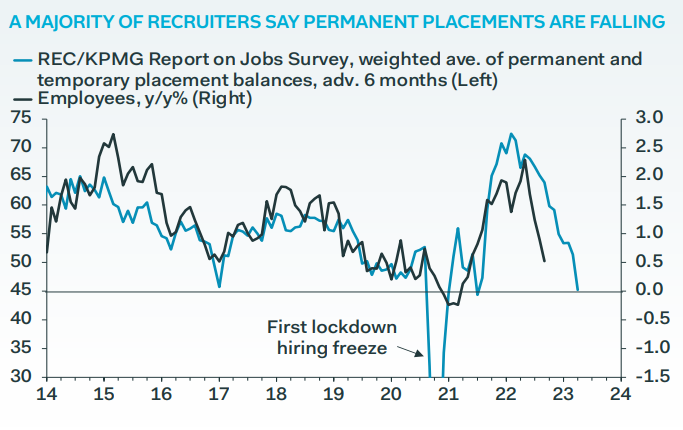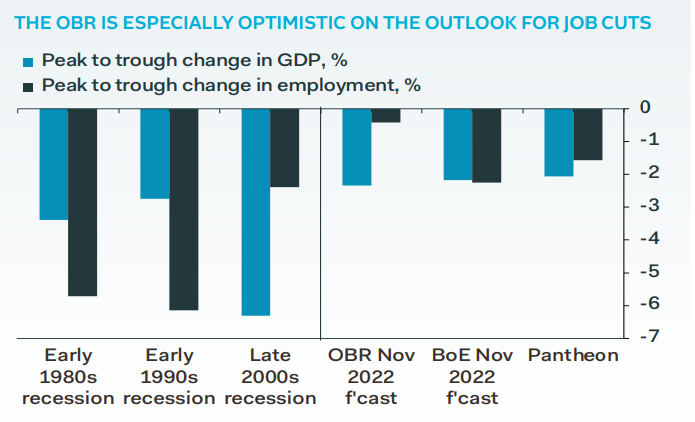Phantom Labour Shortage to Dissipate as UK Unemployment Overtakes Forecasts

Unemployment in the UK: Leading indicators suggest job losses will soon drive unemployment higher and that it could climb faster than many forecasters expect, according to Pantheon Macroeconomics, meaning that a commonly-relented shortage of labour in the UK may now be about to dissipate as if it were a phantom.
S&P Global surveys of purchasing managers in the manufacturing and services industries provided the latest indication this week that demand for workers has softened but are far from the only signs of a faltering labour market that will eventually matter for Bank of England (BoE) interest rate policy.
Notably, growth in the number of permanent and temporary workers placed into employment has fallen recently if data collected by the Recruitment & Employment Confederation (REC) is anything to go by, and Pantheon Macroeconomics estimates that this trend is likely to gather pace.
“The REC Report on Jobs survey—made up of recruitment consultants—pointed in October to year-over-year growth in employees falling to zero by Q2 2023,” says Samuel Tombs, chief UK economist at Pantheon Macroeconomics.
“We think our forecast for employment to drop by 1.5% year-over-year in 2023, with the descent beginning in Q1, is in the right ball park” he adds.
Unemployment in the UK
Leading indicators suggest job losses will soon drive unemployment higher and that it could climb faster than many forecasters expect, according to Pantheon Macroeconomics, meaning that a commonly-relented shortage of labour in the UK may now be about to dissipate as if it were a phantom.
S&P Global surveys of purchasing managers in the manufacturing and services industries provided the latest indication this week that demand for workers has softened but are far from the only signs of a faltering labour market that will eventually matter for Bank of England (BoE) interest rate policy.
Notably, growth in the number of permanent and temporary workers placed into employment has fallen recently if data collected by the Recruitment & Employment Confederation (REC) is anything to go by, and Pantheon Macroeconomics estimates that this trend is likely to gather pace.
“The REC Report on Jobs survey—made up of recruitment consultants—pointed in October to year-over-year growth in employees falling to zero by Q2 2023,” says Samuel Tombs, chief UK economist at Pantheon Macroeconomics.
“We think our forecast for employment to drop by 1.5% year-over-year in 2023, with the descent beginning in Q1, is in the right ball park” he adds.

Unemployment in the UK
An abundance of job vacancies has been prominent among factors cited by the Office for Budget Responsibility, Bank of England and others for forecasts that employment is likely to go little changed through much of next year even as interest rates rise and the economy shrinks in a widely anticipated recession.
But Pantheon’s Tombs says this assumption is unsafe and forecasts that a deteriorating economy will lead unemployment to rise sooner than many others have anticipated, likely precluding along the way any further interest rate rises from the BoE after March next year.
“Vacancy data might overstate labour demand at present, given that online postings cost very little for firms to maintain, and might be for positions which have little hope of being filled at the advertised pay rate, due to the jump in wages this year,” he writes in a Friday research briefing.
“The official vacancy data failed to forewarn of the drop in employment in 2008. Note too that the Insolvency Service must be notified only if more than 20 people will be made redundant at one location. So job redundancies by SMEs, which employ 60% of all staff, will not show up in the HR1 data,” he adds.
Most forecasts suggest the UK’s economy is headed for a deep and lengthy recession but Tombs has flagged that overall employment levels fell simultaneously alongside GDP during the big recession of the early 1990s.

He and colleagues have also noted that employment fell hard on the heels of economy during the recession that followed the 2008 financial crisis
“The U.K.’s labour market is sufficiently flexible that employers can fire staff quickly, if necessary,” Tombs says.
Official data suggested last week that unemployment edged higher from a multi-decade low of 3.5% to 3.6% during September and the BoE has projected it’s likely to reach 4.9% by the end of next year before rising to 6.4% in 2025.
Tombs and colleagues forecast an increase to 4.2% by the end of March and 5% by the end of June, however, leading into a peak of 5.4% in 2024.
“If we’re correct, then the MPC should be willing to end its hiking cycle in March, by which point it probably will have increased Bank Rate to 4%,” Tombs says.
“This points to a bigger squeeze on profits than seen in the late 2000s recession, when employment dropped by just over 2%,” he adds.







